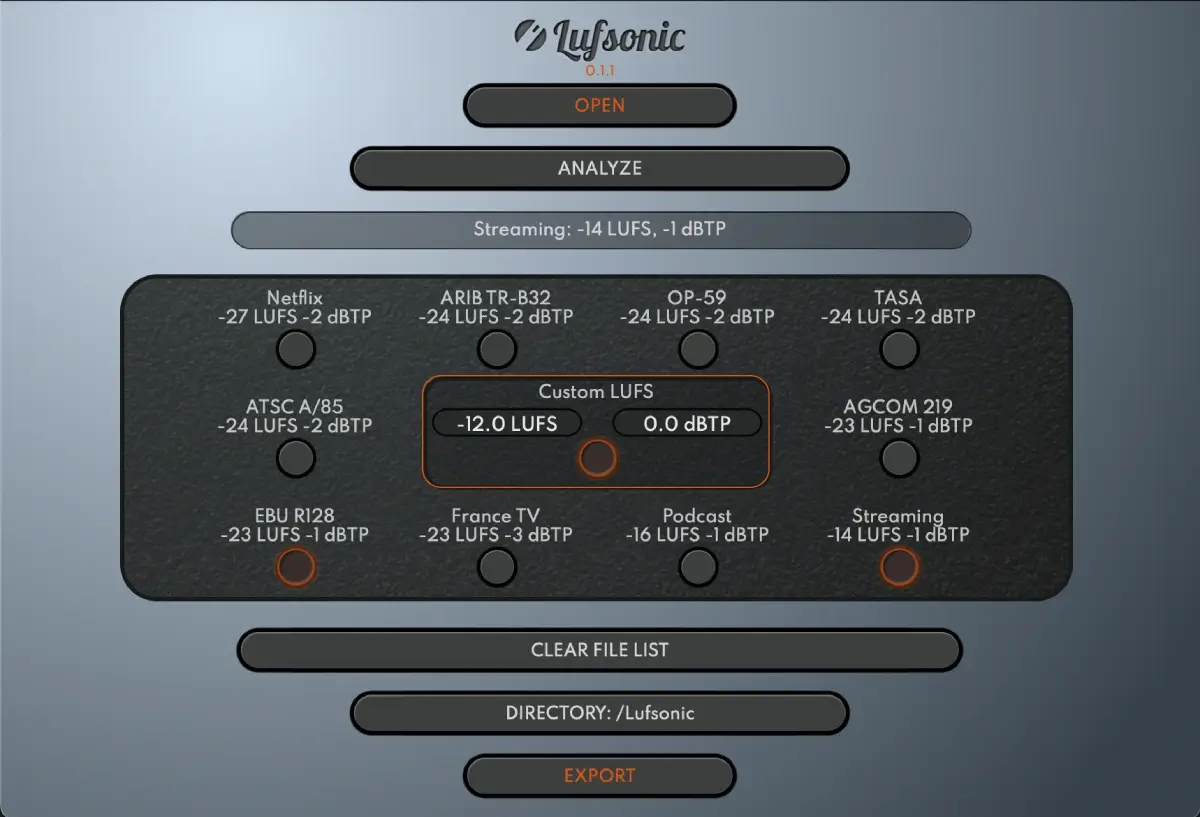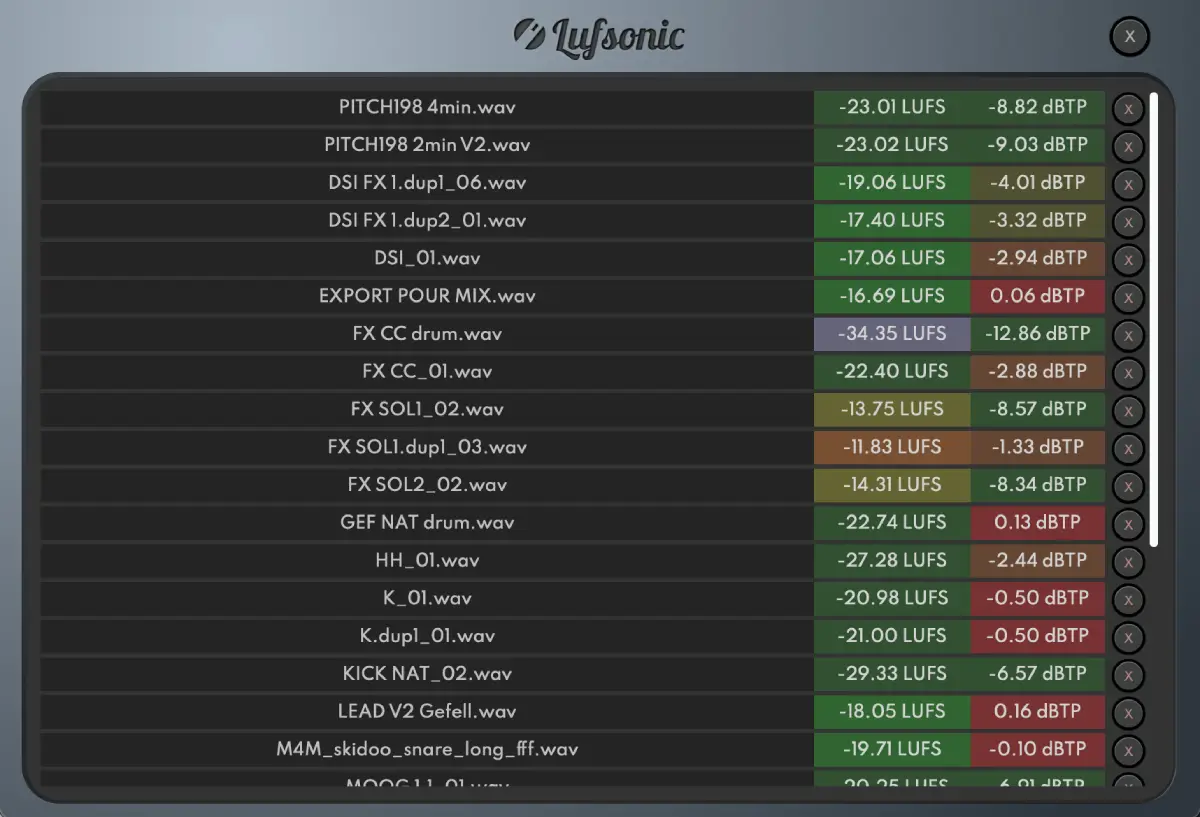Lufsonic: End The LUFS Normalization Nightmare
Instant broadcast-ready audio processing - no DAW, no plugins, no endless render cycles

Every audio professional knows the drill: you need to normalize a batch of audio files to broadcast standards. What should be a simple task becomes an hours-long ordeal involving DAW imports, expensive plugins, multiple playback cycles, and constant adjustments between LUFS targets and dBTP limits.
Whether you're a video editor facing TV broadcast specifications, a mastering engineer handling streaming deliveries, or a post-production specialist managing dozens of audio assets, the traditional LUFS normalization workflow is broken. It's time-consuming, error-prone, and utterly inefficient for batch processing.
The current industry approach to LUFS normalization is a multi-step nightmare that wastes countless hours:
Load your DAW, create a new project, import the audio file. For each individual file. One at a time. Already, you're looking at significant time investment before any actual processing begins.
Purchase and configure specialized LUFS measurement plugins - often costing hundreds of dollars. Options like iZotope Insight, Waves WLM Plus, or NuGen VisLM are professional-grade but come with professional-grade price tags.
Play through the entire audio file to get LUFS measurements. For a 3-minute song, that's 3 minutes of waiting. For a 90-minute film mix, that's 90 minutes just for measurement - before any adjustments.
Based on the LUFS reading, adjust the gain and play through again. Too low? Adjust up and play again. Too high? Adjust down and play again. Each full playthrough required for accurate measurement.
Finally hit your LUFS target, only to discover the dBTP (True Peak) level exceeds broadcast limits. Now you need limiting, which affects your LUFS measurement, requiring another full playthrough cycle.
Once everything measures correctly, export the file. Then repeat this entire process for every single audio file in your project.
Picture this scenario: You're a video editor who just finished a corporate video. The client loves it, approves the final cut, and then drops the bombshell: "We need this for TV broadcast, so it needs to meet EBU R128 standards with -23 LUFS and -1 dBTP limiting."
Suddenly, your completed project becomes a technical nightmare. You don't have expensive mastering plugins, you don't know the intricacies of broadcast standards, and you certainly don't want to call back the audio engineer and pay additional fees for something that should be a simple technical adjustment.
Most video editors face this dilemma by:
The traditional DAW-based approach fails catastrophically when dealing with multiple files. Consider these common scenarios:
Spotify requires -14 LUFS, Apple Music targets -16 LUFS, and YouTube uses -14 LUFS. Processing 12 album tracks through traditional workflows means:
Weekly podcasts require consistent -16 LUFS for major platforms. Traditional processing means a weekly multi-hour ordeal for what should be a simple technical specification.
Training video series with 20+ episodes, each requiring broadcast-ready audio. Traditional workflows make this project a weeks-long technical nightmare.
Lufsonic revolutionizes audio normalization by eliminating the entire traditional workflow. It's the world's first standalone application designed specifically for instant, batch-capable LUFS normalization to professional broadcast standards.

Lufsonic Interface: Revolutionary instant LUFS processing that eliminates traditional DAW workflows
Lufsonic processes files to LUFS standards in seconds, not minutes or hours. No more waiting through full playback cycles - analysis and processing happen almost instantaneously.
Automatically handles the complex relationship between LUFS targets and dBTP limits. No more discovering peak limit violations after lengthy processing cycles.
Process hundreds of files simultaneously with a single drag-and-drop operation. Set your standards once, process everything instantly.

Lufsonic Ultra-fast Analysis: Process hundreds of audio files to multiple LUFS standards simultaneously in just minutes
Select multiple output formats simultaneously. Generate -14 LUFS, -16 LUFS, and -23 LUFS versions in a single processing operation.

Lufsonic Professional Interface: Generate multiple LUFS standards (-14, -16, -23 LUFS) simultaneously for all streaming platforms
Completely standalone application. No need for expensive DAWs, complex session management, or technical audio engineering knowledge.
Eliminates the need for expensive LUFS measurement and limiting plugins. Everything required for professional normalization is built-in.
Lufsonic is the only solution of its kind in the world. While DAW plugins handle LUFS measurement and limiting, no standalone application addresses the specific needs of batch audio normalization to broadcast standards.
Project: Album normalization for 3 streaming platforms (12 tracks)
Traditional Process:
Same Project with Lufsonic:
Lufsonic specifically addresses the video editor's broadcast standards dilemma. No longer do you need to:
Handle broadcast requirements without audio engineering expertise or expensive plugin investments. Accept TV, streaming, and corporate projects with confidence.
Ensure consistent loudness standards across all episodes and platforms. Process weekly shows in minutes instead of hours.
Meet platform-specific loudness requirements for YouTube, Spotify, Apple Music, and other streaming services simultaneously.
Handle large-scale normalization projects efficiently. Process hundreds of assets for broadcast delivery without workflow bottlenecks.
Streamline delivery workflows for multiple streaming platforms. Generate all required formats in single operations.
Ensure internal video content meets broadcast standards for TV advertising, trade show displays, and professional presentations.
Lufsonic employs ITU-R BS.1770-4 compliant LUFS measurement algorithms that meet international broadcast standards for accuracy and reliability.
Sophisticated True Peak detection and limiting ensure compliance with dBTP specifications while maintaining audio quality and meeting LUFS targets.
Multi-threaded processing architecture maximizes system resources for near-instantaneous file processing, regardless of file length or quantity.
Advanced algorithms preserve audio quality while achieving precise loudness targets, ensuring broadcast-ready results without audible artifacts.
Challenge: Client needs 30-second commercial for television broadcast requiring EBU R128 compliance (-23 LUFS, -1 dBTP).
Traditional Solution: Contact audio engineer, additional costs, project delays.
Lufsonic Solution: Drag file into Lufsonic, select EBU R128 standard, process in 10 seconds.
Challenge: Weekly podcast requiring consistent -16 LUFS for Apple Podcasts and Spotify distribution.
Traditional Solution: Complex DAW workflow, expensive plugins, weekly processing hours.
Lufsonic Solution: Batch process all episodes simultaneously to -16 LUFS standard.
Challenge: 12-track album requiring different LUFS standards for Spotify (-14), Apple Music (-16), and CD mastering (-9).
Traditional Solution: Multiple DAW sessions, hours of processing, complex file management.
Lufsonic Solution: Single batch operation generating all three formats simultaneously.
Lufsonic meets international loudness standards including:
Lufsonic represents a fundamental shift from complex, time-intensive workflows to instant, intelligent processing. As content creation accelerates and platform requirements diversify, tools like Lufsonic become essential for professional efficiency.
By eliminating traditional normalization bottlenecks, Lufsonic enables faster content delivery, reduced technical dependencies, and expanded service capabilities across the audio and video production industries.
Lufsonic makes broadcast-quality audio normalization accessible to professionals who previously required specialized expertise or expensive infrastructure.
The audio industry has tolerated inefficient LUFS normalization workflows for too long. Countless hours and substantial financial resources have been wasted on a technical process that modern technology can handle instantly.
Lufsonic changes everything. It's not just an application - it's the liberation of audio professionals from one of the industry's most frustrating technical bottlenecks. For the first time, LUFS normalization becomes as simple as it should have always been.
Whether you're a video editor facing broadcast requirements, a mastering engineer handling streaming deliveries, or any professional dealing with loudness standards, Lufsonic transforms hours of technical complexity into seconds of simple processing.
The choice is clear: continue struggling with outdated, inefficient workflows, or embrace the instant future that Lufsonic provides. In an industry where time is money and deadlines are everything, can you afford not to revolutionize your normalization workflow?
Ready to end the LUFS normalization nightmare? Discover how Lufsonic can transform your audio workflow from hours of frustration to seconds of professional results. Because standards compliance shouldn't require engineering degrees.